Kanji for “Divide”, “Minute”, “Understand”: 分
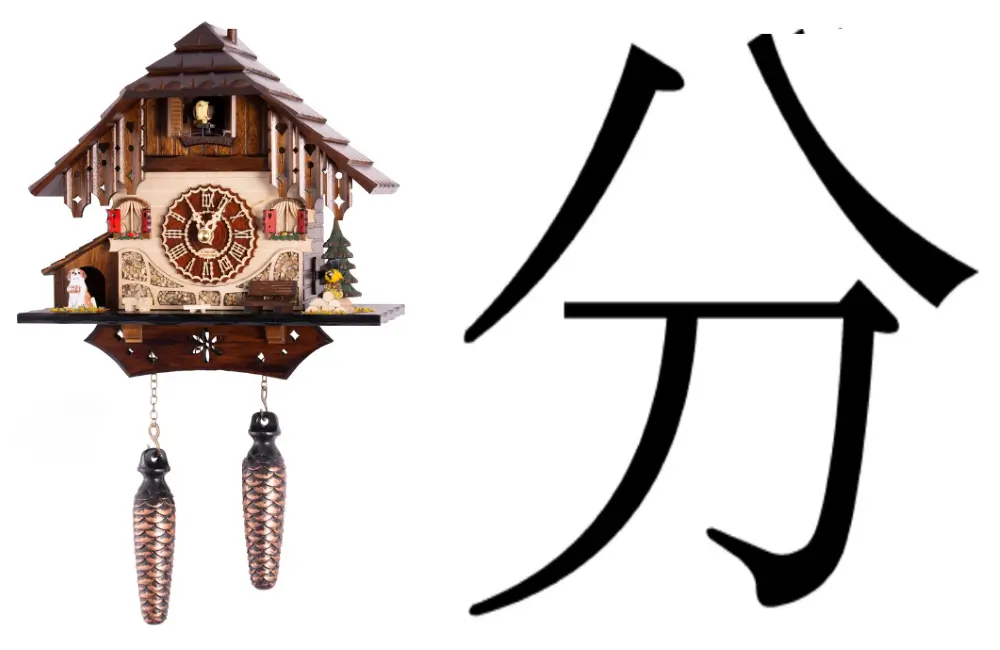
The Japanese kanji meaning “Divide,” “Minute,” or “to understand” is 分.
The kun’yomi (Japanese reading) pronunciation of the Kanji 分 is “wa” (わ), as in words “wakeru” (わける), meaning “to divide” or “to distinguish“; wakareru (わかれる), meaning “to be divided“; wakaru (わかる), meaning “to understand“; wakatsu (わかつ), meaning “to share” or “distribute.”
The on’yomi (Chinese reading) pronunciations of 分 are “bun” (ブン), meaning; “minute;” “fun” (フン); or “bu” (ブ).
The Kanji 分 is constructed with 4 strokes. 見 is part of the JLPT N5 syllabus (please check the list of JLPT N5 Kanji). In Japanese schools, this Kanji is taught in grade 1.
Logic Behind Different Meanings of 分
The original meaning of 分 is to divide, and this meaning relates to the other meanings with the following logic:
- To Understand: It’s easy to understand something in-depth if you divide the information into smaller pieces.
- Minute: Historically, the concept of the hour came first when time measurement was not sophisticated enough to measure smaller units. Later, the hours were divided into minutes. So, a minute was a result of dividing an hour into smaller parts.
Origin of the Shape 分 and the Logic
分 is one of those kanji characters whose shape beautifully describes the meaning “to divide.” Though this kanji’s shape evolved greatly over time, every shape that evolved during this journey kept its meaning and logic intact.
If we see the shapes of 分 in the Oracle Bone Script, Bronze inscription, and small seal script, we see a cutter or knife slicing or dividing something into two parts. The modern shape of this kanji, which we use today, has two divided or sliced parts intact in shape, but the knife has been replaced by the Kanji radical called “sword radical (刀).”
Let’s see the evolution of the shape of the Kanji 分, meaning “divide” or “minute,” from ancient times to the current:
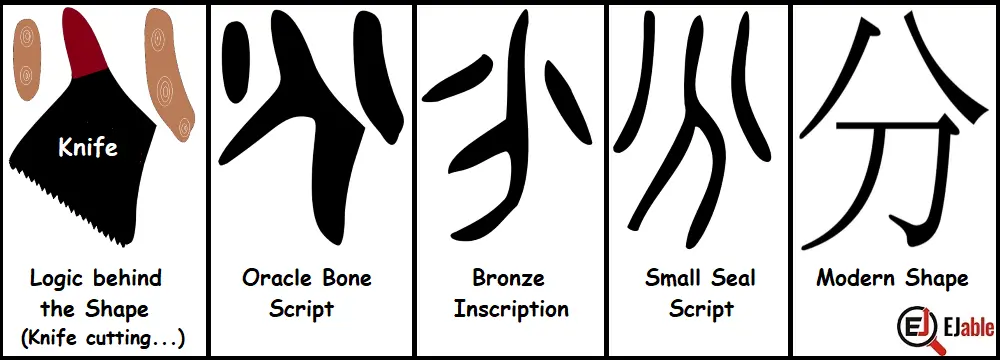

Mnemonic: How to Remember the Kanji 分
The above logic about a knife or sword dividing something into two parts is good enough to memorize the Kanji 分 representing the act of division; however, you can use the following illustration as the mnemonic to remember this Kanji:
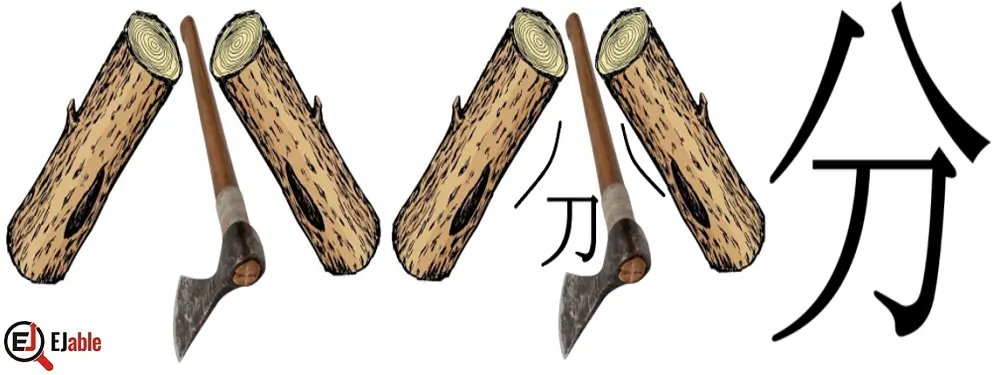

However, it is understandable that it may prove difficult to associate 分 with its entirely different meaning as “minute.” Therefore, the following illustration will work as a mnemonic to associate the Kanji with its meaning “minute”
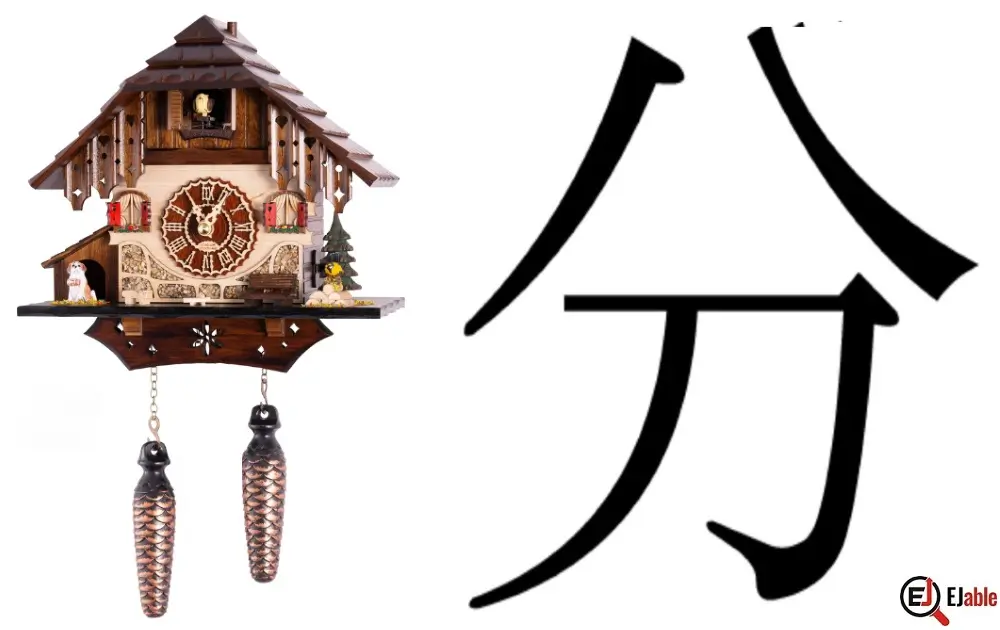

Stroke Order for the Kanji 分
The following illustrations show the order of the 4 strokes to write the Kanji 分:
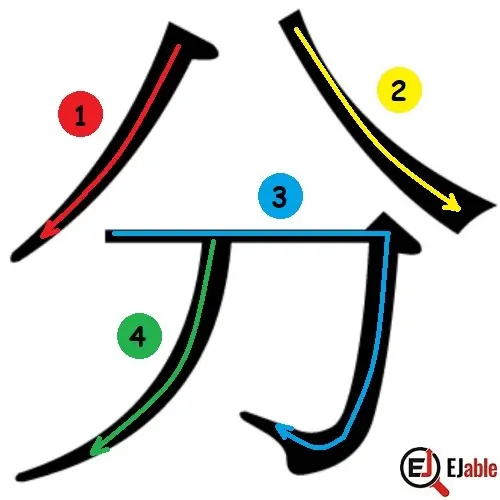

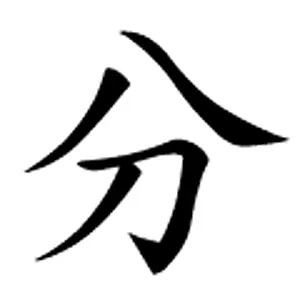

Kanji for Dividing 分 as a Radical or Component
The Kanji 分 is used as a radical or component in 40 Kanji characters, out of which 6 are Jōyō (commonly used) Kanji.
In these other Kanji, 分 contributes meanings related to division, parts, or aspects derived from its core concepts of dividing or sharing.
Examples of Kanji 分 as Radical or Component
Here are the Jōyō Kanji characters that include the 分 radical or component:
- 貧 (ひん / hin): Poor; combines 貝 (shell, symbolizing money) with 分, emphasizing a lack of resources or wealth, denoting poverty or scarcity.
- 粉 (ふん / fun): Powder; integrates 米 (rice) with 分, suggesting the breaking down into finer parts, like powder or flour.
- 紛 (ふん / fun): Confuse; pairs 糸 (thread) with 分, representing entanglement or complexity that leads to confusion.
- 盆 (ぼん / bon): Tray; although its direct relationship to 分 in meaning isn’t as clear, 盆 relates to a container or platform, potentially connecting to the concept of holding or containing parts.
- 雰 (ふん / fun): Atmosphere; merges 雨 (rain) with 分, indicating the spread or dispersal of moisture, contributing to the creation of an atmosphere or ambiance.
- 頒 (はん / han): Distribute; features 頁 (page or head) with 分, alluding to the division and distribution of items or information.
Kanji 分 in Compounded Words
The kanji 分 appears commonly in Japanese and forms part of many compound words. There are 391 Japanese words that begin with the Kanji 分, and it appears in 1342 words.
Examples of Kanji 分 in Compounded Kanji Characters
- 分析 (ぶんせき / bunseki): Analysis; breaking down a whole into its constituent parts to study it.
- 分布 (ぶんぷ / bunpu): Distribution; the way something is spread or distributed across areas.
- 分量 (ぶんりょう / bunryō): Quantity; the amount or portion of something.
- 分別 (ふんべつ / funbetsu): Discrimination; distinguishing or discerning between different things.
- 一部分 (いちぶぶん / ichibubun): A part; a portion or segment of a whole.
- 分子 (ぶんし / bunshi): Molecule; the smallest divisible unit of a compound in chemistry.
- 分担 (ぶんたん / buntan): Share; to take on a portion of a task or responsibility.
- 等分 (とうぶん / tōbun): Equal division; dividing something into equal parts.
- 分野 (ぶんや / bun’ya): Field; a specific area of study or interest, distinguished from others.
- 分類 (ぶんるい / bunrui): Classification; categorizing into groups based on shared characteristics.
- 分数 (ぶんすう / bunsū): Fraction; a mathematical expression representing the division of one quantity by another.
- 命令分 (めいれいぶん / meireibun): Imperative sentence; a grammatical term referring to sentences that give commands, related to the division of sentence types.
- 分岐 (ぶんき / bunki) – Branching; division into separate paths or options.
These examples demonstrate the wide application of the Kanji 分 in Japanese, conveying concepts of division, distribution, understanding, and categorization across various contexts.
Note: Check other Kanji characters on the page “How to Remember Kanji“.


A long-term ex-pat in Japan, Himanshu comes with an IT background in SAP consulting, IT Business Development, and then running the country operations of an IT consulting multinational. Himanshu is the co-founder and Managing Director of ReachExt K.K. and EJable.com. He is also an Advisory Board Member of a Silicon Valley AI/IoT startup.

